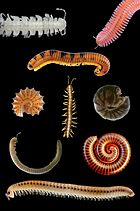| Polyzoniida | |
|---|---|

| |
| Octoglena bivirgata from the western United States | |
| Scientific classification | |
| Domain: | Eukaryota |
| Kingdom: | Animalia |
| Phylum: | Arthropoda |
| Subphylum: | Myriapoda |
| Class: | Diplopoda |
| Subclass: | Chilognatha |
| Infraclass: | Helminthomorpha |
| Clade: | Colobognatha |
| Order: | Polyzoniida Cook, 1895 |
| Families | |
| Synonyms | |
|
Ommatophora Brandt, 1840 | |
Polyzoniida is an order of millipedes in the subterclass Colobognatha.[1][2] This order contains three families and more than 70 described species.[1][3] The species in this order are also known as camphor millipedes, because ozopore secretions in this order frequently have a strong camphor-like smell.[4][3] Poison frogs in South America and Madagascar evidently obtain some of their poison from these millipedes.[3]
Description
[edit]
Millipedes in this order range from 4 mm to 50 mm in length but are usually 10 mm to 15 mm long.[3] Polyzoniidans have a somewhat domed dorsal surface with a flat ventral side. Their heads are small and cone-like, with few ocelli. They lack a dorsal groove and paranota (lateral extensions of each segment).[5] The antennae are relatively thick. These millipedes can have from 20 to 88 segments, with huge variation in segment number within the same species. The body is frequently yellowish or even pink, sometimes featuring characteristic black bands. Legs have six segments. In males, leg pairs 9 and 10 become leglike gonopods in adults. The posterior gonopods typically have from five to seven segments, but the number of segments in the anterior gonopods is more variable. Juveniles hatch with four leg pairs. Females in this order protect their eggs.[3]
Families
[edit]The order Polyzoniida contains three families:[1]
- Hirudisomatidae Silvestri, 1896 (6 genera, 20 species)
- Polyzoniidae Newport, 1844 (6 genera, 22 species)
- Siphonotidae Cook, 1895 (12 genera, 32 species)
Distribution
[edit]This order is distributed worldwide, but in Africa is found only in South Africa and Madagascar.[3] The family Hirudisomatidae occurs from Spain to the Himalayas in Eurasia, Japan, and in North America from southwest Canada to central Mexico. The family Polyzoniidae has a holarctic (northern hemisphere) distribution, occurring in the northwest and northeast United States, eastern Canada, and in Europe from the United Kingdom and France to Siberia. Siphonotidae has a southern distribution, occurring in Brazil and Chile, South Africa, Southeast Asia, Indonesia, Tasmania, and New Zealand.[6][7]
References
[edit]- ^ a b c Shear, William (2011). Zhang, Z. (ed.). "Class Diplopoda de Blainville in Gervais, 1844" (PDF). Zootaxa. 3148 (Animal biodiversity: An outline of higher-level classification and survey of taxonomic richness): 159-164 [159].
- ^ "MilliBase - Polyzoniida". www.millibase.org. Retrieved 2024-08-04.
- ^ a b c d e f Enghoff, Henrik; Golovatch, Sergei; Short, Megan; Stoev, Pavel; Wesener, Thomas (2015-01-01). "Diplopoda — taxonomic overview". Treatise on Zoology - Anatomy, Taxonomy, Biology. The Myriapoda, Volume 2: 363–453 [387-390]. doi:10.1163/9789004188273_017. ISBN 9789004188273.
- ^ Henen, Derek; Brown, Jeff. Millipedes of Ohio (PDF). Ohio Division of Wildlife. pp. 3, 18–19.
- ^ "Diagnostic features of Millipede Orders" (PDF). Milli-PEET Identification Tables. The Field Museum, Chicago. Archived from the original (PDF) on 7 October 2019. Retrieved 25 October 2013.
- ^ "Geographic distribution of Millipede Families" (PDF). Milli-PEET Identification Tables. The Field Museum, Chicago. Archived from the original (PDF) on 29 October 2013. Retrieved 25 October 2013.
- ^ Mesibov, Robert. "Millipede species: Polyzoniida". Tasmanian Multipedes. Archived from the original on 17 December 2014. Retrieved 14 November 2013.
External links
[edit] Media related to Polyzoniida at Wikimedia Commons
Media related to Polyzoniida at Wikimedia Commons Data related to Polyzoniida at Wikispecies
Data related to Polyzoniida at Wikispecies- "Polyzoniida" at the Encyclopedia of Life
- Polyzoniida of Tasmania


